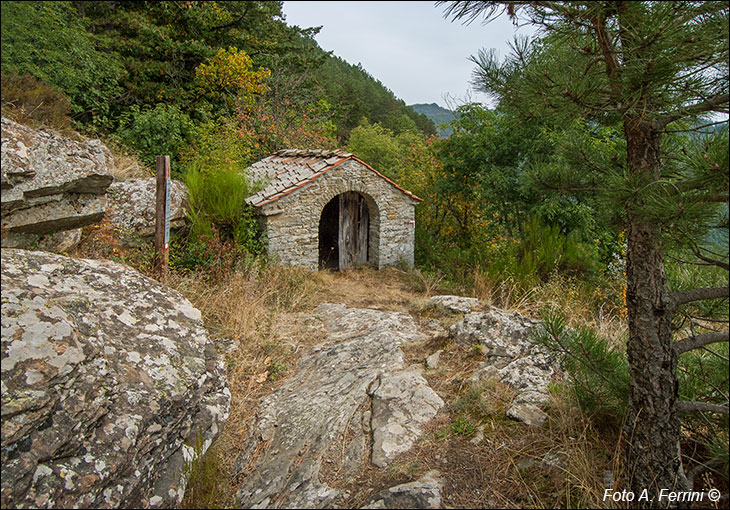Da un castello dei Guidi a un’abbazia benedettina
itinerario sul Pratomagno da Trappola alle Tre Punte, a Santa Trinita e alla Bottigliana
Italiano
ITINERARIO TRAPPOLA – MONTE LORI – BADIA SANTA TRINITA 59
Con poco meno di un chilometro dalla Strada Panoramica del Pratomagno, siamo giunti alla Maestà dell’Orma del Lupo, a 1075 metri di quota. Questo piccolo edificio che sembra incastonato tra le rocce è legato ad una leggenda che spiega il suo nome. Si narra che San Francesco in cammino dal Valdarno, o da Firenze, verso La Verna stesse utilizzando questa mulattiera per salire sul Pratomagno. In questo punto incontrò un branco di lupi affamati. Uno dei quei feroci animali, il più grande, s’interpose tra Francesco e gli altri lupi che ricacciò nel bosco con un impressionante ringhio. Perché quel fatto miracoloso fosse ricordato, la roccia divenne morbida come burro così che il grosso lupo vi lasciò un’impronta. Su quell’orma fu costruito un capanno di pietra che per tantissimi anni ha ospitato coloro che si trovavano a lavorare in questi boschi. Il fatto appena narrato è chiaramente una leggenda, ma attenzione, certe tradizioni non nascono mai dal niente. È probabile che un tempo questa mulattiera, divenuta oggi CAI 22, sia stata un percorso non di San Francesco, ma dei suoi successivi seguaci nei loro spostamenti dalla Verna al Valdarno. With just under a kilometer from the Pratomagno panoramic road, we reached the Maestà dell'Orma del Lupo, at 1075 meters above sea level. This small building that seems set among the rocks is linked to a legend that explains its name. It is said that Saint Francis on his way from Valdarno, or Florence, towards La Verna was using this mule track to climb Pratomagno. At this point he encountered a pack of hungry wolves. One of those ferocious animals, the largest, intervened between Francesco and the other wolves, which he chased back into the woods with an impressive growl. For that miraculous event to be remembered, the rock became soft as butter so that the big wolf left an imprint on it. On that footprint a stone hut was built which for many years hosted those who found themselves working in these woods. The fact just narrated is clearly a legend, but be careful, certain traditions never arise from nothing. It is probable that once upon a time this mule track, which has now become CAI 22, was a route not of Saint Francis, but of his subsequent followers in their movements from Verna to Valdarno.






































































































